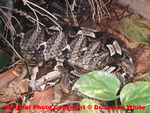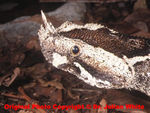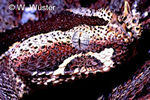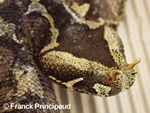|
Bitis nasicornis
|
![Bitis nasicornis ( Rhinoceros horned Viper ) [ Original photo copyright © Dr Julian White ]](images/snakes/SNP02071.jpg)
|
|
Family: Viperidae
|
|
Subfamily: Viperinae
|
|
Genus: Bitis
|
|
Species: nasicornis
|
Common Names
Rhinoceros-horned Viper , Nose-horned Viper , River Jack , Rhinoceros Viper
|
Local Names
Liheri , Ekeli , Ekeri , Essalambwa , Heli , Ki-iri , Ki-ili ,Kikussa , Mpoma , Mpoma Lugondo , Nkondambogo , Pili , Salambwa
|
Region
Sub-Saharan Africa
|
Countries
Benin, Burundi, Cameroon, Central African Republic, Democratic Republic of Congo, Republic of Congo, Cote d'Ivoire ( Ivory Coast ), Equatorial Guinea, Gabon, Ghana, Guinea, Kenya, Liberia, Nigeria, Rwanda, Sierra Leone, Sudan, Tanzania, Togo, Uganda, Cabinda
|
|

|
|
|
|
Taxonomy and Biology
|
|
Adult Length: 0.80 m
|
General Shape
Medium length, slightly depressed with a triangular cross-section, very thick, stout and heavy bodied snake with a short tail. Can grow to a maximum of about 1.25 metres. Head is relatively narrow, flat, triangular and very distinct from narrow neck with strongly keeled scales. Snout is short with 2 or 3 pairs of nasal horns in a cluster. Canthus is distinct. Eyes are medium in size with vertically elliptical pupils. Dorsal scales are rough and heavily keeled with apical pits ( except the outer scale row which is smooth or feebly keeled ).
|
Habitat
Rainforest and primary forest ( both wet and dry ), rarely enters sparse woodland.
|
Habits
Terrestrial and nocturnal snake, but does climb into shrubs and trees to a maximum of about 3 metres above ground level. A good swimmer. sometimes found in shallow forest pools. Mild disposition, slow moving but can strike quickly both forwards and to the side if provoked. Tends to hiss ( quite loudly if angered ) and puff a lot if approached. Prefers to hide in leaf litter, among fallen trees or among root tangles of large trees during the day. Hunts at night by ambush awaiting for prey to come within striking range.
|
Prey
Feeds mainly on rodents, small mammals but has been recorded to occasionally eat frogs, toads and fish.
|
|
|
|
Venom
|
General: Venom Neurotoxins
Unknown
|
General: Venom Myotoxins
Unknown
|
General: Venom Procoagulants
Unknown
|
General: Venom Anticoagulants
Unknown
|
General: Venom Haemorrhagins
Probably present
|
General: Venom Nephrotoxins
Unknown
|
General: Venom Cardiotoxins
Unknown
|
General: Venom Necrotoxins
Unknown
|
General: Venom Other
Unknown
|
|
|
|
Clinical Effects
|
General: Dangerousness
Moderate envenoming possible and potentially lethal
|
|
General: Rate of Envenoming: Unknown but likely to be high
|
|
General: Untreated Lethality Rate: Unknown
|
General: Local Effects
Local pain, swelling, bruising & bleeding
|
General: Local Necrosis
Common, moderate to severe
|
General: General Systemic Effects
Variable non-specific effects which may include headache, nausea, vomiting, abdominal pain, diarrhoea, dizziness, collapse or convulsions
|
General: Neurotoxic Paralysis
Unlikely to occur
|
General: Myotoxicity
Not likely to occur
|
General: Coagulopathy & Haemorrhages
No reports of coagulopathy, though related species can cause bleeding problems
|
General: Renal Damage
Unlikely to occur
|
General: Cardiotoxicity
Insufficient clinical reports to know
|
General: Other
Insufficient clinical reports to know
|
|
|
|
First Aid
|
|
Description: First aid for bites by Viperid snakes likely to cause significant local injury at the bite site (see listing in Comments section).
|
Details
1. After ensuring the patient and onlookers have moved out of range of further strikes by the snake, the bitten person should be reassured and persuaded to lie down and remain still. Many will be terrified, fearing sudden death and, in this mood, they may behave irrationally or even hysterically. The basis for reassurance is the fact that many venomous bites do not result in envenoming, the relatively slow progression to severe envenoming (hours following elapid bites, days following viper bites) and the effectiveness of modern medical treatment.
2. The bite wound should not be tampered with in any way. Wiping it once with a damp cloth to remove surface venom is unlikely to do much harm (or good) but the wound must not be massaged.
3. All rings or other jewellery on the bitten limb, especially on fingers, should be removed, as they may act as tourniquets if oedema develops.
4. The bitten limb should be immobilised as effectively as possible using an extemporised splint or sling; if available, crepe bandaging of the splinted limb is an effective form of immobilisation.
5. If there is any impairment of vital functions, such as problems with respiration, airway, circulation, heart function, these must be supported as a priority. In particular, for bites causing flaccid paralysis, including respiratory paralysis, both airway and respiration may be impaired, requiring urgent and prolonged treatment, which may include the mouth to mask (mouth to mouth) technique of expired air transfer. Seek urgent medical attention.
6. Do not use Tourniquets, cut, suck or scarify the wound or apply chemicals or electric shock.
7. Avoid peroral intake, absolutely no alcohol. No sedatives outside hospital. If there will be considerable delay before reaching medical aid, measured in several hours to days, then give clear fluids by mouth to prevent dehydration.
8. If the offending snake has been killed it should be brought with the patient for identification (only relevant in areas where there are more than one naturally occurring venomous snake species), but be careful to avoid touching the head, as even a dead snake can envenom. No attempt should be made to pursue the snake into the undergrowth as this will risk further bites.
9. The snakebite victim should be transported as quickly and as passively as possible to the nearest place where they can be seen by a medically-trained person (health station, dispensary, clinic or hospital). The bitten limb must not be exercised as muscular contraction will promote systemic absorption of venom. If no motor vehicle or boat is available, the patient can be carried on a stretcher or hurdle, on the pillion or crossbar of a bicycle or on someone's back.
10. Most traditional, and many of the more recently fashionable, first aid measures are useless and potentially dangerous. These include local cauterization, incision, excision, amputation, suction by mouth, vacuum pump or syringe, combined incision and suction ("venom-ex" apparatus), injection or instillation of compounds such as potassium permanganate, phenol (carbolic soap) and trypsin, application of electric shocks or ice (cryotherapy), use of traditional herbal, folk and other remedies including the ingestion of emetic plant products and parts of the snake, multiple incisions, tattooing and so on.
|
|
|
|
Treatment
|
Treatment Summary
Rhinoceros viper bites may cause severe local & systemic envenoming rapidly, requiring urgent assessment & treatment. Fluid shift & shock may occur. Urgent fluid load, good wound care and antivenom (none specific available) are required. While compartment syndrome can occur, it must be confirmed by pressure measurement before considering fasciotomy. Beware any surgical intervention while venom haemorrhagins are active.
|
Key Diagnostic Features
Local swelling, blistering, necrosis + coagulopathy, bleeding
|
General Approach to Management
All cases should be treated as urgent & potentially lethal. Rapid assessment & commencement of treatment including appropriate antivenom (if indicated & available) is mandatory. Admit all cases.
|
Antivenom Therapy
Antivenom is the key treatment for systemic envenoming. Multiple doses may be required. There is no antivenom listed as specific or covering this species, but two antivenoms may be effective (see "Treatment Summary" below; you can find these antivenoms by performing an antivenom search on their names(Subscriber only)).
|
| 1. Antivenom Code: SAfSAI03
|
|
Antivenom Name: SAIMR Polyvalent Antivenom
|
|
Manufacturer: South African Vaccine Producers (Pty) Ltd
|
|
Phone: +27 11 386-6000; +27 11 386-6078
|
Address: Postal address
PO Box 28999
Sandringham 2131
Gauteng Province
Physical address
1 Modderfontein Road
Sandringham, Johannesburg
|
|
Country: South Africa
|
| 2. Antivenom Code: SAfSAIBK
|
|
Antivenom Name: SAIMR Snakebite Kit
|
|
Manufacturer: South African Vaccine Producers (Pty) Ltd
|
|
Phone: +27 11 386-6000; +27 11 386-6078
|
Address: Postal address
PO Box 28999
Sandringham 2131
Gauteng Province
Physical address
1 Modderfontein Road
Sandringham, Johannesburg
|
|
Country: South Africa
|
| 3. Antivenom Code: SAfAVC02
|
|
Antivenom Name: Polyvalent Snake Antivenom
|
|
Manufacturer: National Antivenom and Vaccine Production Centre
|
|
Phone: ++966-1-252-0088 ext 45626, 45637.
|
Address: P.O. Box 22490
Riyadh 11426
|
|
Country: Saudi Arabia
|
| 4. Antivenom Code: SAfIBM01
|
|
Antivenom Name: Antivipmyn Africa
|
|
Manufacturer: Instituto Bioclon
|
|
Phone: ++56-65-41-11
|
Address: Calzada de Tlalpan No. 4687
Toriello Guerra
C.P. 14050
Mexico, D.F.,
|
|
Country: Mexico
|
| 5. Antivenom Code: SAfICP07
|
|
Antivenom Name: Pan-African antivenom (EchiTAb-Plus-ICP)
|
|
Manufacturer: Instituto Clodomiro Picado
|
|
Phone: ++506-2511-7888
|
Address: Contiguo a la plaza de deportes,
Dulce Nombre de Coronado.
San José
Costa Rica
|
|
Country: Costa Rica
|
|
|
|
Images
|

|

|

|

|
|
|
|
Bitis nasicornis ( Rhinoceros horned Viper ) [ Original photo copyright © Dr Julian White ]
|
Bitis nasicornis ( Rhinoceros horned Viper ) [ Original photo copyright © Dr Julian White ]
|
Bitis nasicornis ( Rhinoceros horned Viper ) [ Original photo copyright © Dr Wolfgang Wuster ]
|
Bitis nasicornis ( Rhinoceros horned Viper ) [ Original photo copyright © Franck Principaud]
|
|
|
|
|
|



